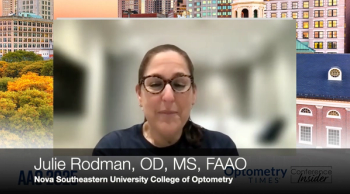
Biologics: A new road into the future of medicine
Speaking at the American Academy of Optometry 2021 annual meeting in Boston, Anthony DeWilde, OD, FAAO, discussed biologics, which hold promise for the treatment of ophthalmic diseases.
Reviewed by Anthony DeWilde, OD, FAAO
Biologics is a newer category of medication that target specific markers in the body to reduce the burden of disease, and a number of these products are available to treat ocular diseases and systemic diseases that manifest in the eye, according to Anthony DeWilde, the director of Tele-Eye Imaging Program at the Kansas City VA Medical Center, andadjunct instructor at the University of Missouri College of Optometry in Kansas City, Missouri.
Speaking at the American Academy of Optometry 2021 annual meeting in Boston, DeWilde explained that biologics are made from living organisms. These products can contain proteins that control other proteins, genes that control production of vital proteins, modified human hormones, or cells that suppress/activate immune system components.
Biologics are not to be confused with biosimilars, which are products that are very close in nature to original reference product in all areas, including molecular structure, safety, and efficacy.
As with all treatments, this biologics comes with side effects such as rashes at the injection site, infection, headache, allergic reaction, and increased risk of tuberculosis.
Current biologic uses
The current most common uses of biologics are for anti-tumor necrosis factor (TNF), anti-interleukin (IL), and anti-calcitonin gene-related peptide (CGRP) activity in autoimmune diseases, such as inflammatory bowel disease, ankylosing spondylitis, Graves’ disease, myasthenia gravis, and migraine and cluster headaches. Ocular diseases that can be targeted with biologics are exudative age-related macular degeneration, neurotrophic keratopathy, and uveitis.
Systemic diseases with ocular ramifications
Biologics are being introduced to replace the older therapies such as steroids that are associated with more and serious side effects.
Inflammatory bowel disease, an autoimmune disorder, causes stomach pain, bloody stools, and diarrhea, and in the eye, acute anterior unilateral nongranulomatous uveitis. Usual treatments include steroids, aminosalicylates and immune suppression with azathioprine and methotrexate. Biologics indicated for IBS include infliximab (Remicade, Janssen Biotech Inc.), adalimumab (Humira, AbbVie Inc.), and ustekinumab, (Stelara, Janssen Biotech Inc.).
Psoriasis, which produces a white patchy rash at the joints and scalp and possible joint pain, also can cause acute anterior unilateral nongranulomatous uveitis. Treatments include topical steroids, vitamin D analogues, light therapy, and immune suppression with cyclosporine and methotrexate. In addition to the biologics mentioned previously, etanercept, (Enbrel, Amgen Inc,) and guselkumab, (Tremfya, Janssen Biotech Inc.) can be prescribed.
Ankylosing spondylitis, also often associated with acute anterior unilateral nongranulomatous uveitis, causes low back pain that worsens with rest and improves with movement and responds to nonsteroidal anti-inflammatory drugs (NSAIDs). Treatments include NSAIDs, physical therapy and anti-TNF biologics (Humira, Enbrel, Remicade, or Cimzia (certolizumab pegol, UCB Inc.) or anti-IL biologics (Taltz (ixekizumab), Eli Lilly and Co.) and secukinumab, (Cosentyx, Novartis).
Migraine, defined as unilateral painful headache, produces visual aura, in addition to an array of physical disturbances. Current preventative treatments include topiramate (Topamax, Janssen), beta-blockers, verapamil, amitriptyline, and Botox injections. The anti-CGRP options for both migraines and cluster headaches include fremanezumab-vfrm, (Ajovy, Teva Pharmaceuticals USA, Inc), galcanezumab (Emgality, Lilly), and erenumab (Aimovig, Amgen).
The anti-CGRP benefits include reductions of both the number of headaches and their intensity, DeWilde pointed out.
Other systemic conditions that can be treated with biologics are juvenile idiopathic arthritis, myasthenia gravis, diabetic, rheumatoid arthritis, lupus, and multiple sclerosis.
Ocular diseases treatable with biologics
Giant cell arteritis, characterized by ocular signs and symptoms of pallid edema, amaurosis fugax, possibly diplopia, and central retinal artery occlusion, can cause severe visual loss. The ocular concern is anterior ischemic optic neuropathy (AION). The most prominent systemic symptoms are jaw claudication, neck pain, scalp tenderness, and headache. The disease can become bilateral in a third of patients with AION within 14 days.
Treatments include intravenous and oral steroids with a long taper, disease-modifying antirheumatic drugs, methotrexate, and the biologic tocilizumab (Actemra, Genentech).
DeWilde recounted a recent study1 that evaluated tocilizumab compared with placebo. The 4 study groups included tocilizumab weekly compared with bi-weekly with a 26-week prednisone taper) and placebo with a 26-week and a 52-week prednisone taper.
The results showed that tocilizumab treatment resulted in sustained remission at 52 weeks; the weekly dose was successful in 56% of patients and the biweekly dose in 53% compared with placebo (26 weeks) in 14% and placebo (52 weeks) in 18%. The cumulative prednisone doses in the 4 study arms were 1,862 mg in both the tocilizumab arms, and 3,296 mg and 3,818 mg.
The adverse events included injection-site reactions; more serious side effects were seen in the arms in which prednisone alone was administered.
Neurotrophic keratopathy generally presents unilaterally in patients with a history of trauma, cerebrovascular accident, and herpetic infections. The patient complaints include ocular irritation, foreign-body sensation, epiphora, blurry vision, and a less degree of pain than might be expected. Treatments included lubricating agents, use of a bandage contact lens, tarsorrhaphy, amniotic membrane, plasma rich protein, and the biologic cenegermin (Oxervate, Dompé U.S. Inc.). The major disadvantage of cenegermin is the cost-$29,000 for 7 vials. The cost can drop substantially if the patient complete paperwork. The 8-week requires administration 6 times daily.
The results of 2 recent studies2,3 showed that cenegermin was superior to placebo; in both studies cenegermin resulted in corneal healing in 70% compared with 43% and 29% with placebo.
Graves’ disease is an autoimmune disease that affects the eyes, thyroid, skin, and mental health. The treatments help both ocular problems (diplopia) and systemic problems to control the thyroid, and inflammation. Ocular surgeries, i.e., orbital decompression, strabismus surgery, and eyelid retraction, are options.
The available biologic for these patients with active Graves’ disease is teprotumumab, (Tepezza, Horizon Therapeutics), which has resulted in a 2-mm reduction in proptosis in up to 83% of patients compared to 20% with placebo. Treatment includes a total of 8 infusions every weeks with a cost of $46,000 for 3 vials of the therapeutic.
Exudative age-related macular degeneration is currently treated largely with anti-vascular endothelial growth factor drugs, which are all biologics, i.e., ranibizumab (Lucentis, Genentech), bevacizumab (Avastin, Genentech), and brolucizumab (Beovu, Novartis). Injections of these agents are administered monthly until resolution of the choroidal neovascularization and then a treat-and-extend regimen is adopted.
Uveitis (noninfectious) can now be treated with adalimumab that reduces the intensity and the recurrences of the disease.
“Biologics hold a lot of promise for treating ophthalmic diseases,” DeWilde concluded. “This approach is providing improved outcomes with reduced side effects. The current downside is the high cost.”
Anthony DeWilde, OD, FAAO
This article is adapted from DeWilde’s presentation at the American Academy of Optometry 2021 annual meeting. He has no financial interest in this subject matter.
---
References
- Stone JH, Tuckwell K, Dimonaco S, et al. Trial of tocilizumab in giant cell arteritis. N Engl J Med 2017;377:317-28.
- Bonini S, Lambiase A, Rama P, et al., REPARO Study Group. Phase II randomized, double-masked, vehicle-controlled trial of recombinant human nerve growth factor for neurotrophic keratitis. Ophthalmology 2018;125:1332–43
- Pflugfelder SC, Massaro-Giordano M, Perez, VL, et al. Topical recombinant human nerve growth factor (cenergermin) for neurotrophic keratopathy: A multicenter randomized vehicle-controlled pivotal trial. Ophthalmology 2020;127:14–26.
Newsletter
Want more insights like this? Subscribe to Optometry Times and get clinical pearls and practice tips delivered straight to your inbox.



















































.png)


